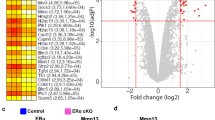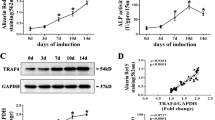Abstract
Our previous study showed that estrogen stimulates membrane-type matrix metalloproteinases-1 (MT1-MMP) production in osteoblastic cells culture, but has no effect on MMP-2 and TIMP-2 synthesis. Osteoblast-derived MT1-MMP have been recently implied to play a role in bone metabolism by degrading tumor necrosis factor-a (TNF-α), resolving extracellular matrix and activating proMMP-2, which requires the process of activation mediated by MT1-MMP/tissue inhibitor of metalloproteinase (TIMP-2) complex on the cell surface. To investigate the mechanism of bone loss following estrogen deficiency, we examined the effects of estrogen on osteoblast synthesis of MT1- MMP, MMP-2 and TIMP-2. In situ hybridization and immunohistochemistry of rat bone samples were used to document the synthesis of MT1-MMP, MMP-2, and TIMP-2 mRNA and protein. Osteoblasts from distal femoral head showed an increase in the pattern of MT1-MMP mRNA and protein production in sham-operated controls and 17β- estradiol (E2)-treated rats, compared with the ovariectomized group; the synthesis of MMP-2 and TIMP-2 mRNA and protein was unaffected. Our data show a down-regulation of MT1-MMP synthesis by osteoblast in vivo following estrogen withdrawal, and treatment with E2 resulted in induced MT1-MMP expression in vivo. There is evidence suggesting a role for MT1-MMP in the process of bone loss during the pathogenesis of osteoporosis.
Similar content being viewed by others
References
Turner RT, Riggs BL, Spelsberg TC. Skeletal effects of estrogen. Endocr Rev 1994, 16: 275–300.
Rifas L, Fausto A, Scott MJ, Avioli LV, Welgus HG. Expression of metalloproteinase and tissue inhibitor of metalloptroteinase in human osteoblast-like cells: metalloproteinase biosythesis. Endocrinology 1994, 134: 213–21.
Sato H, Takino T, Okada Y, Cao J. et al. A matrix metalloproteinase expressed on the surface of invasive tumor cells. Nature 1994, 370: 61–5.
Westermarck J, Kahari V. Regulation of matrix metalloproteinase expression in tumor invasion. FASEB J 1999, 13: 781–92.
D’Ortho MP, Will H, Atklnson S, et al. Membrane-type matrix metalloproteinase 1 and 2 exhibit broad-spectrum proteolytic capacities comparable to many matrix metallo-proteinases. Eur J Biochem 1997, 250: 751–7.
Liao EY, Luo XH, Deng XG, Wu XP. Effects of 17b-estradi-ol on the expression of nembrane-type matrix metallo-proteinase-1 (MT1-MMP) and matrix metalloproteinase-2 (MMP-2) in human osteoblastic MG-63cell cultures. J Endocrinol Invest 2001, 24: 876–81.
Zuker S, Drews M, Conner C. Tissue inhibitor of metalloproteinase-2 (TIMP-2) binds to the catalytic domain of the cell surface receptor, membrane type 1-matrix metalloproteinase (MT1-MMP). J Biol Chem 1998, 273: 1216–22.
Kanayma HO, Yokota KY, Kurokawa Y, Murakami Y, Nishitani M, Kagwa S. Prognostic values of matrix metal-loproteinase and tissue inhibitor of metalloproteinase-2 expression in bladder cancer. Cancer 1998, 82: 1359–66.
Wang Z, Juttermann R, Soloway PD. TIMP-2 is required for efficient activation of proMMP-2 in vivo. J Biol Chem 2000, 275: 26411–5.
Ko YC, Langley KE, Mendiaz EA, Parker VP, Taylor SM, DeClerck YA. The C-terminal domain of tissue inhibitor of metalloproteinases-2 is required for cell binding but not for antimetalloproteinase activity. Biochem Biophys Res Commun 1997, 236: 100–5.
Emmert-Buck MR, Emonard HP, Corcoran ML, Foidart JM, Stetler-Stevenson WG. Cell surface binding of TIMP-2 and pro-MMP-2/TIMP-2 complex. FEBS Lett 1995, 364: 28–32.
Imai K, Ohuchi E, Aoki T, et al. Membrane-type matrix metalloproteinase 1 is a gelatinolytic enzyme and is secreted in a complex with tissue inhibitor of metalloproteinase 2. Cancer Res 1996, 56: 2707–10.
Will H, Atkinson SJ, Butler GS, Smith B, Murphy G. The soluble catalytic of membrane type 1 matrix metalloproteinase cleaves the propeptide of progelatinase A and initiates autoproteolytic activation. J Biol Chem 1996, 271: 17119–23
Pei D, Weiss SJJ. Transmembrane-deletion mutants of the membrane-type matrix metalloproteinase-1 process progelatinase A and express intrinsic matrix-degrading activity. J Biol Chem 1996, 271: 9135–40.
Gilles C, Polette M, Coraux C et al. Contribution of MT1-MMP and of human laminin-5 y2 chain degradation to mammary epithelial cell migration. J Cell Sci 2001, 114: 2967–76
Quaranta V. Cell migration through extracellular matrix: membrane-type metalloproteinases make the way. J Cel Biol 2000, 149: 1167–70.
McClelland P, Onyia JE, Miles RR, et al. Intermittent administration of parathyroid hormone (1–34) stimulates matrix metalloproteinase-9 (MMP-9) expression in rat long bone. J Cell Biochem 1998, 70: 391–401.
Holmbeck K, Bianco P, Caterina J, et al. MT1-MMP-defi-cient mice develop dwarfism, osteopenia, arthritis, and connective tissue disease due to inadequate collagen turnover. Cell 1999, 99: 81–92.
Gearing AJH, Beckett P, Christodoulou M, et al. Processing of tumor necrosis factor-a precursor by metalloproteinases. Nature. 1994, 370: 555–7.
McGeehan GM, Becherer JD, Bast RC Jr, et al. Regulation of tumor necrosis factor—a processing by a metalloproteinase inhibitor. Nature 1994, 370: 558–61.
Manolagas SC, Jilka RL. Bone marrow, cytokines, and bone remodeling. Emerging insights into the pathophysiology of osteoporosis. N Engl J Med 1995, 332: 305–11
Author information
Authors and Affiliations
Corresponding author
Rights and permissions
About this article
Cite this article
Liao, E.Y., Liao, H.J., Guo, L.J. et al. Membrane-type matrix metalloproteinase-1 (MT1-MMP) is down-regulated in estrogen-deficient rat osteoblast in vivo . J Endocrinol Invest 27, 1–5 (2004). https://doi.org/10.1007/BF03350902
Accepted:
Published:
Issue Date:
DOI: https://doi.org/10.1007/BF03350902




